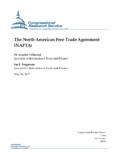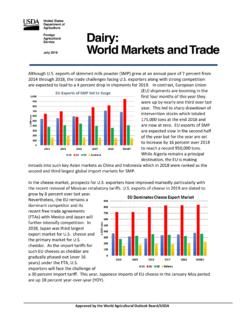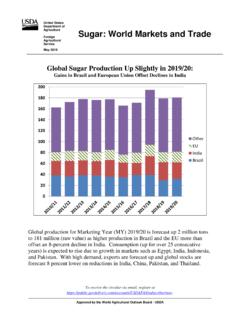Transcription of The State of Agricultural Commodity Markets 2018
1 Agricultural trade ,CLIMATE CHANGE ANDFOOD SECURITYAGRICULTURALCOMMODITY MARKETS20182018201820182018 THE State OFEGYPT: Siwa Oasis is one of the best illustrations of farmers ingenuity to adapt agriculture to very harsh climatic conditions by managing scarce water resources to rear livestock and grow indigenous crops to respond to local PHOTOGRAPH West Siwa Development ProjectThis flagship publication is part of THE State OF THE WORLD series of the Food and Agriculture Organization of the United citation:FAO. 2018. The State of Agricultural Commodity Markets 2018. Agricultural trade , climate change and food securit y. Rome. Licence: CC BY-NC-SA designations employed and the presentation of material in this information product do not imply the expression of any opinion whatsoever on the part of the Food and Agriculture Organization of the United Nations (FAO) concerning the legal or development status of any country, territory, city or area or of its authorities, or concerning the delimitation of its frontiers or boundaries.
2 The mention of specific companies or products of manufacturers, whether or not these have been patented, does not imply that these have been endorsed or recommended by FAO in preference to others of a similar nature that are not 978-92-5-130565-2 FAO 2018 Some rights reserved. This work is made available under the Creative Commons Attribution-NonCommercial-ShareAlike IGO licence (CC BY-NC-SA IGO; ).Under the terms of this licence, this work may be copied, redistributed and adapted for non-commercial purposes, provided that the work is appropriately cited. In any use of this work, there should be no suggestion that FAO endorses any specific organization, products or services.
3 The use of the FAO logo is not permitted. If the work is adapted, then it must be licensed under the same or equivalent Creative Commons license. If a translation of this work is created, it must include the following disclaimer along with the required citation: This translation was not created by the Food and Agriculture Organization of the United Nations (FAO). FAO is not responsible for the content or accuracy of this translation. The original English edition shall be the authoritative edition. Any mediation relating to disputes arising under the licence shall be conducted in accordance with the Arbitration Rules of the United Nations Commission on International trade Law (UNCITRAL) as at present in materials.
4 Users wishing to reuse material from this work that is attributed to a third party, such as tables, figures or images, are responsible for determining whether permission is needed for that reuse and for obtaining permission from the copyright holder. The risk of claims resulting from infringement of any third-party-owned component in the work rests solely with the , rights and licensing. FAO information products are available on the FAO website ( ) and can be purchased through Requests for commercial use should be submitted via: Queries regarding rights and licensing should be submitted to: and Agriculture Organization of the United NationsRome, 20182018 Agricultural trade , CLIMATE CHANGE AND FOOD SECURITYAGRICULTURAL Commodity MARKETSTHE State OF | ii |CONTENTSFOREWORD ivMETHODOLOGY viACKNOWLEDGEMENTS vii ACRONYMS AND ABBREVIATIONS xEXECUTIVE SUMMARY xiiPART 1 Agricultural trade : KEY DYNAMICS AND TRENDS 1 The evolution of Agricultural trade .
5 2000 2016 2 Agricultural policy trends 9 PART 2 THE LINKAGES BETWEEN Agricultural trade , FOOD SECURITY AND CLIMATE CHANGE 13 Climate change, agriculture and Agricultural trade 14 Long-term foresight analysis of climate change impacts on Agricultural trade 19 PART 3 Agricultural trade AND CLIMATE CHANGE: EXPLORING THE POLICY SPACE 31 Paris Agreement and the World trade Organization (WTO) Agreements 32 Relationship between WTO regulations and the Paris Agreement 38 Policy space for effective implementation of Nationally Determined Contributions (NDCs) 40 PART 4 ADAPTING TO CLIMATE CHANGE AND MITIGATING ITS IMPACT: DOMESTIC POLICIES AND SUPPORT MEASURES 43 Policies targeting adaptation and mitigation in production under the Agreement on Agriculture 44 Policies for emissions reduction 53 Assessing the policy space for domestic support: adaptation and mitigation in the context of the Agreement on Agriculture 58 PART 5 ADAPTING TO CLIMATE CHANGE AND MITIGATING ITS IMPACT: THE ROLE OF trade POLICIES 61 The role of trade and trade policies in climate change adaptation 62 The role of trade in mitigating the impact of climate change 69 Assessing the policy space for trade policies.
6 Adaptation and mitigation in the context of WTO obligations 72 PART 6 NON-TARIFF MEASURES (NTMs): REGULATIONS AND STANDARDS 75 Technical Barriers to trade (TBT) and environmental protection 76 Sanitary and Phytosanitary Measures (SPS) Agreement 78 GLOSSARY 85 NOTES 86| iii |TABLES, FIGURES AND BOXES TABLES Major importers of Agricultural products: share of total import value, 2016 and 2000 Major exporters of Agricultural products: share of total export value, 2016 and 2000 Climate change and food security Total domestic support Annex 2 of the Agreement on Agriculture: Green Box support measures Effects of a USD 20 tax per tonne of carbon dioxide equivalent on selected Agricultural prices for selected countries (percent increase) Impact of emissions leakage through trade 70 FIGURES World merchandise trade value and world GDP: annual growth rates, 2000 2016 Agricultural price indices, 1990 2018 (2002 2004=100) Food Price Index volatility, January 1991 March 2018 (percent) Evolution of South South Agricultural trade , 2000 2015 Least Developed Countries: Agricultural trade (USD billion), 2000 2015 Sub-Saharan Africa.
7 Net Agricultural trade (USD billion), 2000 2013 Average Agricultural applied tariff rates, weighted average (percent), 2000 2016 Producer Nominal Protection Coefficient, 2000 2016 Changes in Agricultural production in 2050: climate change relative to the baseline Baseline and climate change crop yield assumptions, percent change 2011 2050 Changes in Agricultural net trade in 2050: climate change scenario relative to the baseline (in billion USD, 2011 constant prices) Changes in Agricultural production and net exports in selected countries and regions in 2050: climate change scenario relative to the baseline Increases in exports of Agricultural products in 2050: climate change relative to the baseline (in billion USD, 2011 constant prices) Decreases in exports of Agricultural products in 2050: climate change relative to the baseline (in billion USD, 2011 constant prices) Changes in GDP in 2050: climate change scenario relative to the baseline scenario Changes in GDP in selected countries and regions in 2050: climate change scenario relative to the baseline Changes in food prices in 2050.
8 Climate change scenario relative to the baseline Changes in food prices and food purchasing power in selected countries/regions in 2050: climate change scenario relative to the baseline Sources of growth in global Agricultural output Maize imports, 2000 2016 (billion USD) Impact of open Markets on net trade positions under climate change in 2050 65 BOXES 2 .1 Agricultural trade , climate change and nutrition Limitations of long-term foresight analysis Climate change and chokepoints of global food trade System drivers and scenarios in the modelling analysis The impact of climate change on fisheries Implementation mechanisms under the Kyoto Protocol and Paris Agreement The US Gasoline case Developing countries: special and differential treatment Regional food reserves Cap-and- trade schemes Regulatory policies.
9 Deforestation and biofuels Import financing for developing countries The effects of global Agricultural market integration Estimating the carbon footprint of Agricultural products 79 FOREWORDFOREWORDT here will be no sustainable future without eradicating poverty and hunger. Ensuring food security for all is both a key function of and a challenge for agriculture, which faces ever-increasing difficulties as populations rise, urbanization increases and incomes grow, the Agricultural sector will be under mounting pressure to meet the demand for safe and nutritious food. Agriculture has to generate decent jobs and support the livelihoods of billions of rural people across the globe, especially in developing countries where hunger and poverty are concentrated.
10 Furthermore, the sector has a major role to play in ensuring the sustainability of the world s precious natural resources and biodiversity, particularly in light of a changing cl i mate. Climate change will have an increasingly adverse impact on many regions of the world, with those in low latitudes being hit the hardest. This means that countries in Africa, Asia and Latin America, many of which already suffer from poverty, food insecurity and various forms of malnutrition, will be disproportionately at risk. Agriculture in these regions will be negatively affected. Regions with temperate climates, on the other hand, could see positive impacts, with warmer weather benefitting their Agricultural sectors.
















